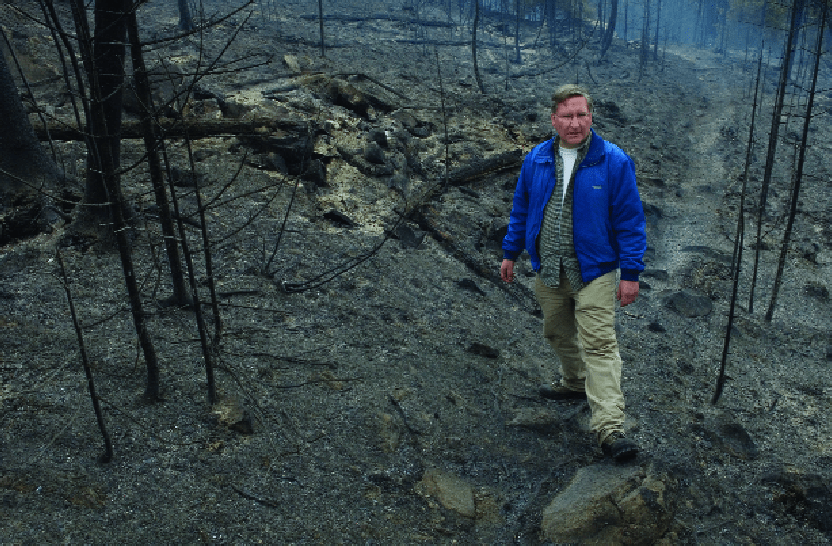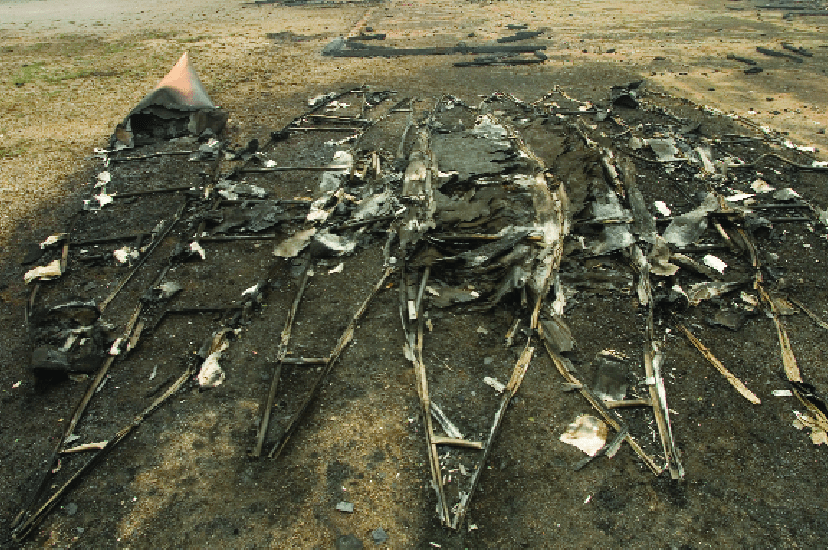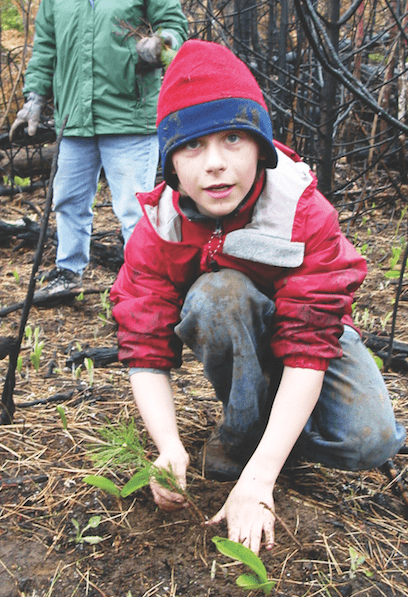Three stories from the recent fire offer perspective: in a healthy forest, fire nourishes and revitalizes the soil and the landscape, and that in life, adversity can create new opportunities and new beginnings.

© Layne Kennedy 2007
Survival
By Michael Kelberer, Wilderness News Contributor
On Friday May 4th, Lee Frelich, Gus Axelson, and Layne Kennedy were on assignment in the Boundary Waters Canoe Area Wilderness doing a story on global warming. One day later, they found themselves in the midst of a warming of a decidedly different sort, as the Ham Lake fire roared up the east side of Seagull Lake and headed for their campsite at the Seagull Palisades. Here is Lee’s account:
“On the morning of the 5th of May we were on Three-Mile Island in Seagull Lake looking at the ancient cedars. We started to paddle away from the island when we saw this puff of smoke way to the south of us. We decided to land on Eagle’s Nest Island and climb the hill to investigate the smoke. By the time we arrived, only 20 minutes later, this plume of smoke was already covering most of the sky. That’s how fast the fire grew.”
“I teach classes on forest fires at the University of Minnesota, so I’m familiar with fire behavior. And, with 40-mile-an-hour winds in a really dry conifer forest, I knew this fire was going to be a major event. We paddled back to the Palisades where we had made camp. We spent the next two days climbing hilltops trying to figure out which way the wind was blowing and where the fire was headed next—we were trying to plan where we would go.”
“During the day, all we could do was assume that the direction of the densest smoke was probably where the fire was. But at night, when we climbed up on the Palisades, we could see balls of flame that were probably 150 feet high. We could see that it had reached up as far north as the southern part of Saganaga, and with the wind still coming from the southeast, we were worried that it would get around the east end of Seagull Lake and then head towards us.”
“In fact, Sunday night, you could walk around in the forest without a flashlight—the whole eastern sky was completely orange, like sunrise at midnight.” “We were threatened by the fire, but we were trapped by the winds. It was just a few days after ice-out, and the water was near freezing. With a 40-mile-an-hour wind on a lake that big, you’re not going anywhere
in canoes. Even the crossing of Seagull that we made from Eagle’s Nest Island to the Palisades was probably the worst crossing I’ve ever made: 34-degree water, with the bow of the canoe clearing by only an inch as we went into each wave.”
“Finally, on Monday morning, the winds shifted to the west and diminished, blowing the fire away from us, and making an escape by canoe possible. We took advantage and paddled from the Palisades to Dominion Island where the Wilderness Canoe Base is located. The camp was on fire, we turned north and headed up the Seagull River to the Trail’s End campground. As we made our exit, the east side of the Seagull River was on fire while the west side, where the campground is, had just a few trees torching up.”
“When we landed at the campground a hotshot crew came down and asked if I was Lee. They had been waiting for us, because, of course, we had filed our permit and they knew we were in the BWCAW on Seagull. In fact, we were the only party out there.”
Devastation
By Alissa Johnson, Wilderness News Contributor

© Layne Kennedy 2007
Wilderness Canoe Base grew out of the Plymouth Christian Youth Center in 1956 to give urban youth a Christian community away from the distractions of daily life. Its prime island location on Seagull Lake has been ideal for introducing youth to the spirituality of Minnesota’s Northwoods. This spring, however, it was directly in the path of the Ham Lake fire. The fire leveled nearly forty of the site’s sixty buildings, razing much-needed facilities and decades of memories. Yet according to director Jedidiah Scharmer, the shock and sadness were quickly tempered by an outpouring of support.
Volunteers, financial support, and building supplies flooded in immediately. A full time staff person was brought in just to answer the inquiries. With this tremendous support and the remaining facilities, there was never reason to doubt whether WCB would remain open. The base could still support the more than seventy scheduled high school canoe trips, and affiliated camps would run the remaining residential programs. From there, a massive clean up effort began.
Volunteers and staff removed scrap metal and crumbled foundations, and combed the ground with large magnets to remove nails. Debris was hauled to the docks, transferred across the lake by boat, and carted by trailer to a county-hosted demolition site twelve miles away. All the while staff training needed to be run and decisions made about rebuilding.
A recent partnership with Lake Wapogasset Lutheran Bible Camp had already sparked discussions and dreams for the future of Wilderness Canoe Base. The Ham Lake fire accelerated the timeline for acting on them. To balance short-term needs with long-term goals, temporary shelters support this summer’s programming. Long-term rebuilding will take place over the next few years with the input of the WCB community and professional guidance. Though everyone is anxious to see Wilderness Canoe Base fully recovered, no one is willing to sacrifice the time to do it right.
In the meantime, reforestation efforts are underway. White pine seeds donated by Dyke Williams and the Quetico Superior Foundation have been dispersed. The University of Minnesota Forestry Department, which uses WCB as a base for Boundary Waters studies, has planted trees to study the fire’s effects on red and white pine. Natural reforestation is also at work. The jack pines are returning and the landscape is greening. Though WCB may look like a fraction of its former self, its essence remains intact. Youth continue to forge connections to nature, to their traveling companions, and to their faith and their God.
In a healthy forest, fire nourishes and revitalizes the soil and the landscape. In life, adversity can also create new opportunities and new beginnings. Through their dedication and determination, the staff and volunteers at Wilderness Canoe Base have transformed the Ham Lake fire from a story of tragedy to one of hope and faith. Scharmer says it best, “Out of it all we are finding hope, a hope to rebuild, a hope that comes in tight knit communities that live together in love through difficult times and a hope that occurs because over and over we see campers, guests, work crews and alumni who come here and are overjoyed with the hard work and possibilities that this fire has provided.”
To learn how you can help Wilderness Canoe Base in its efforts to rebuild, visit the website at www.wildernesscanoebase.org
Renewal
By Alissa Johnson, Wilderness News Contributor

© Tuscarora Outfitters 2007
As the Ham Lake fire neared containment and evacuated Gunflint Trail residents and business owners set their sights on returning home, the uncertainty of what they would return to made it difficult to tackle one big question: “What next?” Many would return to homes and land ravaged by the fire. Among the displaced were members of the Gunflint Trail Association, and they wanted to do something to help. Their discussions led to an idea: give residents tree seedlings as the Trail reopened so they could carry with them a sense of renewal as they returned.
As association members made arrangements under the guidance of Nancy Seaton, co-owner of Hungry Jack Outfitters and chair
of the Gunflint Trail Scenic Byway Committee, local property owner Dyke Williams learned of their plans. A Quetico Superior Foundation board member, Williams coordinates its white pine initiative, a major planting effort to restore the declining health of the white pine in the north country. He arranged for the donation of 6,000 white pine seedlings, and QSF covered handling and shipping. Volunteers secured a variety of additional seedlings, and what began as a simple gesture grew into a 2-day event over Memorial Day weekend.
Just days after the Trail reopened, area residents and volunteers gathered at Blankenburg Landing on Sea Gull Lake to begin planting. Thanks to media coverage that included the Star Tribune and Minnesota Public Radio, volunteers came from as far away as the Twin Cities to help. Seaton estimates that 200 or more people planted over the course of the weekend, but emphasized that it was important to let property owners approach the day in their own way. While some were excited to receive help, others chose to plant alone as they came to terms with the effects of the fire.
The event undoubtedly created the sense of renewal organizers had hoped for. By the end of the weekend, the seedlings were
the only green to dot the landscape; it was a welcome site. Seaton spoke of one resident in particular who chose to plant alone that first Saturday. Returning the next day, he confided that it felt like a rebirthing to plant on his land; it had given him the ability to look forward again. On Sunday, he invited volunteers to help him plant more trees.
The weekend was such a success that plans are forming for a second annual event. Seaton and the committee are working to expand the planting beyond private land through a partnership with the U.S. Forest Service. Planting is scheduled for May 3, 2008 to take advantage of more favorable growing conditions in early spring.
As for this year’s seedlings? Sue Ahrendt of Tuscarora Lodge and Outfitters, who participated in the planting, reports that weather conditions have been ideal for growing since Memorial Day. There has been plenty of rain, and the ferns have come up, providing protection for the seedlings. What began as an act of hope by residents has been continued by Mother Nature’s gradual restoration of the land. Both serve as a reminder that with faith and courage, the Gunflint Trail and the lives of the people who call it home will renew.
This article appeared in Wilderness News Summer 2007

